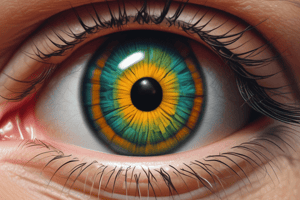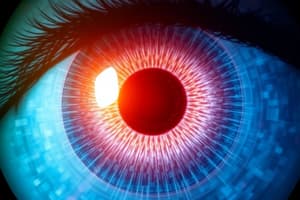Podcast
Questions and Answers
What is a primary feature of High-pass resolution perimetry?
What is a primary feature of High-pass resolution perimetry?
- Patients see rings with a light central region. (correct)
- It tests only the central visual field up to 30 degrees.
- It uses a dark background for stimuli presentation.
- Patients identify flickering stimuli.
Why is peripheral testing important in some diseases?
Why is peripheral testing important in some diseases?
- It helps in identifying central scotomas.
- It is crucial for diagnosing myopia.
- It evaluates static vision at extreme angles.
- It aids in detecting conditions like retinitis pigmentosa. (correct)
Which method is considered best for determining the shape and location of scotomas?
Which method is considered best for determining the shape and location of scotomas?
- Automated perimetry.
- Kinetic perimetry.
- High-pass resolution perimetry.
- Classic tangent screen and bowl perimeter examination. (correct)
What characteristic differentiates static from kinetic perimetry?
What characteristic differentiates static from kinetic perimetry?
What is a limitation of automated visual field testing procedures?
What is a limitation of automated visual field testing procedures?
What is a necessary condition during perimetric testing?
What is a necessary condition during perimetric testing?
Which automated technique shows sensitivity to early losses in glaucoma?
Which automated technique shows sensitivity to early losses in glaucoma?
Which aspect of visual field testing is primarily assessed through the Amsler Grid?
Which aspect of visual field testing is primarily assessed through the Amsler Grid?
What is the primary purpose of using larger and more visible targets when frank scotomas are found?
What is the primary purpose of using larger and more visible targets when frank scotomas are found?
Which technique involves comparing the visual fields of a patient and a clinician?
Which technique involves comparing the visual fields of a patient and a clinician?
What should occur if there are no substantial peripheral field deficits during confrontation testing?
What should occur if there are no substantial peripheral field deficits during confrontation testing?
What is the function of the Amsler grid in visual testing?
What is the function of the Amsler grid in visual testing?
What phenomenon may prevent a patient from recognizing the presence of scotomas?
What phenomenon may prevent a patient from recognizing the presence of scotomas?
When may no definite conclusion about scotomas be made during Amsler grid testing?
When may no definite conclusion about scotomas be made during Amsler grid testing?
Which technique is used to test more peripheral regions of the visual field?
Which technique is used to test more peripheral regions of the visual field?
What is the twofold purpose of testing color vision?
What is the twofold purpose of testing color vision?
What is the primary focus of automated perimetry devices in visual field testing?
What is the primary focus of automated perimetry devices in visual field testing?
Which testing method analyzes threshold data for patterns typical of glaucomatous field loss?
Which testing method analyzes threshold data for patterns typical of glaucomatous field loss?
What property is the frequency-doubling perimetry test particularly sensitive to for early glaucoma detection?
What property is the frequency-doubling perimetry test particularly sensitive to for early glaucoma detection?
How does the central visual system respond to contrast at higher spatial frequencies?
How does the central visual system respond to contrast at higher spatial frequencies?
What advantage does the frequency-doubling illusion provide in visual field tests?
What advantage does the frequency-doubling illusion provide in visual field tests?
Which characteristic is NOT assessed by graphical display printouts in visual sensitivity testing?
Which characteristic is NOT assessed by graphical display printouts in visual sensitivity testing?
In confrontation visual field testing, how is the examiner's performance most crucial?
In confrontation visual field testing, how is the examiner's performance most crucial?
Which aspect of visual processing do Amsler Grid tests mainly evaluate?
Which aspect of visual processing do Amsler Grid tests mainly evaluate?
Which factor does NOT significantly affect the visibility of stimuli in frequency-doubling perimetry testing?
Which factor does NOT significantly affect the visibility of stimuli in frequency-doubling perimetry testing?
Flashcards
Confrontation Testing
Confrontation Testing
Compares the patient's visual field with the clinician's by having both look at a midpoint.
Pseudoperimeter Technique
Pseudoperimeter Technique
Sweeping a target along an arc behind the patient to test peripheral vision.
Amsler Grid
Amsler Grid
Examines central visual function to characterize disturbances.
Short Wavelength Automated Perimetry (SWAP)
Short Wavelength Automated Perimetry (SWAP)
Signup and view all the flashcards
High-Pass Resolution Perimetry
High-Pass Resolution Perimetry
Signup and view all the flashcards
Kinetic Perimetry
Kinetic Perimetry
Signup and view all the flashcards
Static Perimetry
Static Perimetry
Signup and view all the flashcards
Glaucoma Hemi-Field Test
Glaucoma Hemi-Field Test
Signup and view all the flashcards
Frequency-Doubling Perimetry
Frequency-Doubling Perimetry
Signup and view all the flashcards
Frequency-Doubling Illusion use
Frequency-Doubling Illusion use
Signup and view all the flashcards
Tangent Screen & Bowl Perimeter
Tangent Screen & Bowl Perimeter
Signup and view all the flashcards
Study Notes
Tangent Screen & Bowl Perimeter
- Larger targets are used to assess functional detection ability when scotomas are found
- Coarse screening for peripheral field loss can be performed by confrontation or similar techniques
- In confrontation testing, the patient’s visual field is compared with the clinician's visual field
- This is done by both clinician and patient looking through a mid-point between their eyes
- If no peripheral field deficits are present, the point of appearance and disappearance of the test target should be at approximately the same location for both clinician and patient
- Pseudoperimeter technique is used by sweeping a target along an arc starting behind the patient
- This technique helps test the peripheral regions of the field, especially in the temporal side
- The Amsler grid examines central visual function and characterizes disturbances of central vision
Automated Perimetry
- Short wavelength automated perimetry (SWAP) presents a large blue target on a bright yellow background
- Automated perimetry procedures often involve detection of flickering stimuli, motion, or displacements
- High-pass resolution perimetry presents rings with a light center and two dark circles on either side
- Automated perimeters include programs that present stimuli beyond 30 degrees
- Automated visual field testing procedures have advantages from consistent control of test stimuli, procedures, and the analysis of results
- The classic perimetric techniques of tangent screen and bowl perimeter examination are not as commonly used today
- They remain the best methods for determining scotoma shape and location
- Illumination conditions must be controlled
Visual Field Testing
- Kinetic perimetry involves a clinician moving the target across the visual field
- Static perimetry techniques involve the turning on and off of a target at specific locations
- Graphic display printouts typically show regional variations in visual sensitivity
- Most automated perimetry devices concentrate on testing the central 25 to 30 degrees of the visual field
- The glaucoma hemi-field test analyses threshold data and compares the relative sensitivity of selected regions in the superior and inferior visual fields
- New visual field tests specify visual processing of information originating in different regions of the visual field
- These tests attempt to identify deficits in neural processing mechanisms that may be vulnerable to diseases
Frequency-Doubling Perimetry
- A central visual field test where a 5-degree square of flickering grating is presented at 17 different locations
- The grating has a spatial frequency of less than 1 cycle per degree
- When presented in rapid counterphase flicker (more than 15 Hz), there is the illusion of twice as many stripes in the target pattern
- The visibility of the stimulus is relatively unaffected by optical defocus, ambient illumination, pupil diameter, or media clarity
- The frequency-doubling illusion relies on the sparse large-diameter magnocellular nerve fibers, which are vulnerable to glaucoma
- This test is reported to be sensitive for the early detection of glaucoma
Studying That Suits You
Use AI to generate personalized quizzes and flashcards to suit your learning preferences.




